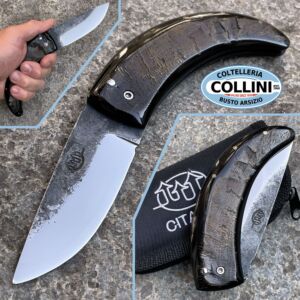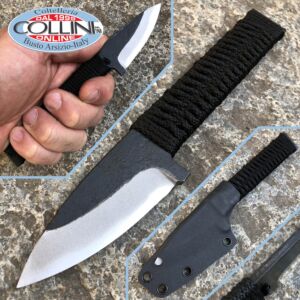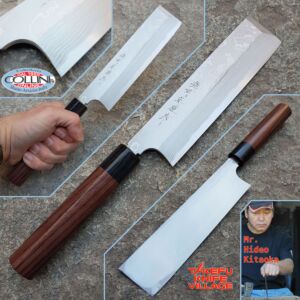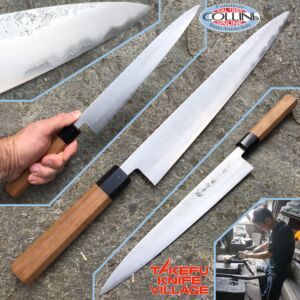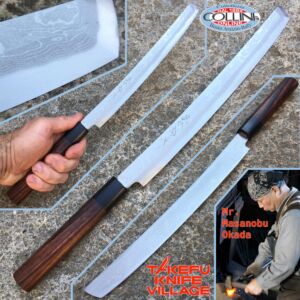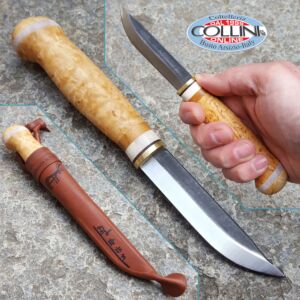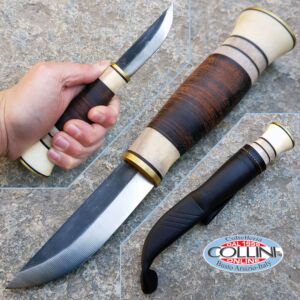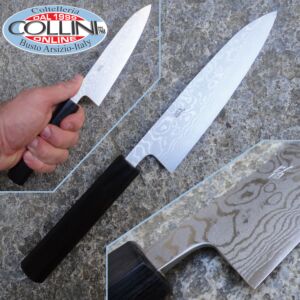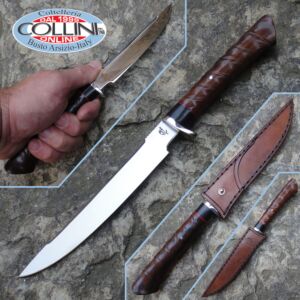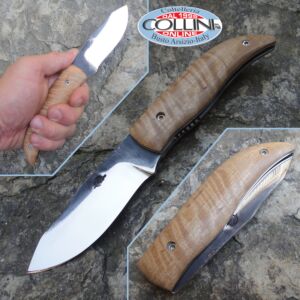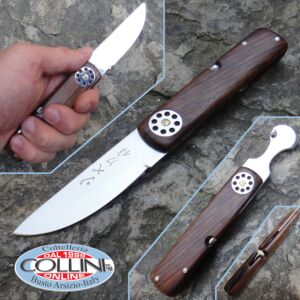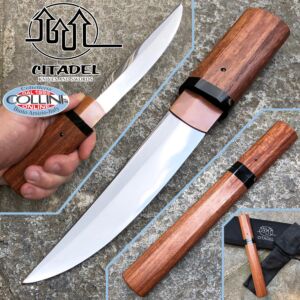Last up date
-
Citadel - Hunting knife - PRIVATE COLLECTION - handmade knife
KNIFE WITHDRAWN FROM A PRIVATE COLLECTION
* Origin: Withdrawn from a private individual, previously purchased
* Conditions: in like-new condition
* Available on the market: No longer available
* Sharpening: Factory
* Marks on blade: None
* Marks on handle: None
* Box: /
* Sheath: hand-made leather in good condition
* Manuals, Certificates and Guarantees: No
* Checked and Certified by our internal laboratoryIntended use: collection/sports
Type of production: Handcrafted
Blade production: Cambodia
Blade: mirror-finish DNH7 carbon steel
Blade treatment: brut de forge
Handle: wood and horn
Blade length: approx. 120mm.
Blade thickness: approx. 5.5mm.
Total length: approx. 250mm.
Balance: -
Weight: approx. 228g.
Lock: 1.5cm set back
Sheath: Handcrafted leather
Notes: -Citadel Knives and Swords is a sword and knife manufacturer based in Phnom Penh, Cambodia. Despite the country's reputation as an exotic and remote location, the company is easily accessible, located close to the city's international airport. The workshop is modest but houses an impressive range of high-quality Japanese swords and knives.
Founded by Dominique Eluere in the 1990s, Citadel has combined the expertise of French and local craftsmen to produce blades that rival the best in the world. Eluere began by training Cambodian blacksmiths to make French table knives, later evolving into the production of Japanese swords.
The quality of Citadel swords is world renowned, thanks to the use of traditional Japanese techniques and a meticulous manufacturing process. Each katana is heat treated, creating a blade with varying hardness along the edge and spine, a hallmark of true katanas. The hilt is fully encased in high-quality stingray leather, a rarity compared to common panels.
Attention to detail extends to every element, with every component custom-made for each blade. This includes the tsuba (sword guard) and habaki (blade collar), both of which are hand-crafted and fitted, ensuring perfect fit and functionality.
In addition to katanas, Citadel also produces European swords and knives, maintaining the same philosophy of quality and functionality. Production is artisanal, with particular attention to polishing and finishing, often done by hand with sandpaper and whetstones.
Citadel is proud of its Cambodian roots, with local workers looking up to Eluere as a father figure and deeply involved in maintaining the company's high standards.
In short, Citadel Knives and Swords represents a perfect fusion of tradition, craftsmanship and innovation, offering products that are truly functional works of art. These tools, while expensive, represent an investment in quality and craftsmanship that is hard to match.
AP-CIT-COR -
Citadel - Lancha Rayskin White knife - handmade knife
Intended use: sports / collection
Type of production: Artisan
Production Lama: Cambodia
Blade: in DNH7 carbon steel with 40 / 60HRC selective hardening
Blade treatment: -
Handle: stingray leather
Blade length: 90mm.
Blade thickness: 4mm.
Closed length: 120mm.
Total length: 210mm.
Thick when closed: 25mm.
Balancing: -
Weight: 188g.
Closure: liner lock
Clip: -
Sheath: cordura bag
Packaging: -
Note: -AP-CIT-LRW -
Citadel - Rossignoli Folder Big - friction folding knife - craft knife
Intended use: sports / collection
Type of production: Artisan
Production Lama: Cambodia
Blade: in DNH7 carbon steel with 40 / 60HRC selective hardening
Blade treatment: -
Handle: Water Buffalo Horn
Blade length: 95mm.
Blade thickness: 4mm.
Closed length: 137mm.
Total length: 205mm.
Thick when closed: 23mm.
Balancing: -
Weight: 146 g.
Closure: folding with friction
Clip: -
Sheath: Cordura bag
Packaging: -
Note: -CD4211 -
Citadel - Iaito Steel craft - DNH7 - selective hardening - practice sword
These handcrafted iaito stand out for their classic line and for their functional quality, which is well coupled with the traditional manufacturing techniques and the materials used.
The blades are carbon hardened to a hardness of about 40 HRC after which, after being hammered by hand, the back and sides are covered with clay and the wire is tempered to 60 HRC for excellent cutting, penetration and flexibility. The blade is then hand-polished on stone and the sword is finished in every single detail.Given the high craftsmanship nature of these swords, we would like to clarify that the photo is purely for illustrative purposes as designs of tsuba fuchi and kashira may differ from the one shown here as well as the weights and measures of the sword may differ, albeit slightly. .
Blade: in DNH7 steel with high carbon content with selective clay hardening 60 / 40HRC not sharpened
Hamon: irregular Gunome style
Hi: bo-hi
Blade length: 71.5cm.
Motohaba: 3cm.
Sakihaba: 2.2cm.
Sori1.5cm
Blade thickness: 5.5mm.
Kissaki: 3.5cm.
Tsukamaki length: 25.5cm.
Total length: 102.5cm.
Katana weight: 910g.
Weight with Saya: 1170g.
Balance: advanced, at 12.5cm. from Tsuba
Saya: black lacquered wood and buffalo horn
Tsuka-ito: -
Sageo: -
Tsuba: antiqued metal
Fuchi, Kashira, Menuki, Seppa and Shitodome: bronze
Country of production: Cambodia
Habaki: copper
Note: -
Small technical glossary: Hamon: temper line on the blade * Hi: deep groove in the blade, also called blood-cola * Saya: sword sheath * Tsuka-Ito or Tsuka-gawa: weaving in cotton, silk or leather that wraps around the handle * Tsuba: guard * Fuchi: ornament between guard and handle * Kashira: ornament at the end of the handle * Menuki: medallions placed under the cord of the handle * Habaki: collar that wraps the beginning of the blade * Seppa: seals of the guard * Shitodome: seals to which the Sageo is linked * Sori: curvature of the bladeCI5106 -
Takefu Village - Takobiki Knife 260mm by Mr. Masanobu Okada - F-276R - kitchen knife
Takefu Knives Village is a brand born in 1991 in Echizen Fukui, a city in Japan famous since 1400 for the production of knives.
The Takefu knives brand is based on the union of 10 local artisans who make each knife by hand.The model presented is made by:
Mr. Masanobu Okada
Born in the city of Echizen in 1949, the third generation of forging artisans, he is one of the few living heirs of the "masaoki-ho" typical of Echizen, a forging technique that consists in hammering and folding the steel giving it a rhomboid shape for get a thinner, sharper and easier to sharpen steel sheet.Initially specialized in the production of agricultural tools with the Monjiro brand, in recent times he began to produce artisanal kitchen knives with the traditional "uchi-hamono" technique, also receiving the title of Dentoukougeishi (traditional craftsman) after having undergone the strict examinations of the commission of the Traditional Crafts Industry Promotion Association Foundation.
The uchi-hamono technique (uchi means blow and hamono means cutting tool) finds its origins towards the end of the 1300s, in the Muromachi period and consists of manually beating with a hammer and repeatedly a heated steel sheet until a blade of cut. Many tools made with this particular method are still on permanent display at the MoMA (Museum of Modern Art) in New York.
In a recent interview Mr. Okada said: "I have been engaged with this art for over 45 years, but still today I still think that it is an infinite world where the notions learned never become obsolete and for this I feel I have to transmit them. to the younger generations ". Currently, under his careful guidance, two apprentices are thoroughly learning the blade polishing techniques.
Characteristics of the knife:Use: meat / fish
Blade: CladSteel carbon steel with cutting edge in White Paper Steel (Shirogami) at 62 / 64HRC and damascus with 67 layers
Provenance Lama: Japanese craftsmanship
Handle: SandalWood, very hard and water resistant wood
Packaging: in cardboard with Japanese writing
Blade length: 265mm
Total length: 410mm
Blade thickness: from 3.5mm to 3mm
Handle Length: 139mm
Weight: 178g* Not every knife is signed on the blade by the craftsman who made it
Maintenance:
Considering the high carbon steel used for the blade and the extreme construction quality of these knives, we recommend a series of attentions to be followed to maintain the quality of the product over time.- Never put the knife in the dishwasher
- Rinse the knife with hot water before first use
- Rinse the knife immediately after each use without aggressive dishwashing detergent and dry with a soft cloth (always starting at the back of the cutting edge)
- Aggressive foods such as lemon juice must be promptly rinsed immediately after use
- Do not use glass or granite plates as a cutting support. Use only wooden bases
- Pay attention that the cutting edge of the knife does not come into contact with other metal objects during its storage to avoid damage to the cutting edge.
Invia commenti
Cronologia
Salvate
CommunityF-276R -
Takefu Village - Tanto Kiridashi knife - by Mr. Masanobu Okada - 6 cm - Japanese craftsmanship
Takefu Knives Village is a brand born in 1991 in Echizen Fukui, a city in Japan famous since 1400 for the production of knives.
The Takefu knives brand is based on the union of 10 local artisans who forge each knife by hand
Characteristics of the knife: Mr. Masanobu Okada
Use: collection / sports
Blade: three-layer clad steel with a 62 / 63HRC Shirogami cutting edge
Lama origin: Japan
Handle: black paracord
Packaging: -
Blade length: 60mm
Total length: 165mm
Blade thickness: 4mm
Production: artisanal
Weight: 79gSheath: in kydex handcrafted by Simone Tonolli
OKD-10B-S-BL -
Takefu Village - Drop Point Kiridashi knife - by Mr. Masanobu Okada - 7.5 cm - Japanese craftsmanship
Takefu Knives Village is a brand born in 1991 in Echizen Fukui, a city in Japan famous since 1400 for the production of knives.
The Takefu knives brand is based on the union of 10 local artisans who forge each knife by hand
Characteristics of the knife: Mr. Masanobu Okada
Use: collection / sports
Blade: three-layer clad steel with a 62 / 63HRC Shirogami cutting edge
Lama origin: Japan
Handle: black paracord
Packaging: -
Blade length: 75mm
Total length: 190mm
Blade thickness: 4mm
Production: artisanal
Weight: 114gSheath: in kydex handcrafted by Simone Tonolli
OKD-20A-BL -
Takefu Village - Spear Point Kiridashi knife - by Mr. Masanobu Okada - 6 cm - Japanese craftsmanship
Takefu Knives Village is a brand born in 1991 in Echizen Fukui, a city in Japan famous since 1400 for the production of knives.
The Takefu knives brand is based on the union of 10 local artisans who forge each knife by hand
Characteristics of the knife: Mr. Masanobu Okada
Use: collection / sports
Blade: three-layer clad steel with a 62 / 63HRC Shirogami cutting edge
Lama origin: Japan
Handle: black paracord
Packaging: -
Blade length: 60mm
Total length: 167mm
Blade thickness: 4mm
Production: artisanal
Weight: 78gSheath: in kydex handcrafted by Simone Tonolli
OKD-10D-BL -
Takefu Village - Skinner Kiridashi knife - by Mr. Masanobu Okada - 6.5 cm - Japanese craftsmanship
Takefu Knives Village is a brand born in 1991 in Echizen Fukui, a city in Japan famous since 1400 for the production of knives.
The Takefu knives brand is based on the union of 10 local artisans who forge each knife by hand
Characteristics of the knife: Mr. Masanobu Okada
Use: collection / sports
Blade: three-layer clad steel with a 62 / 63HRC Shirogami cutting edge
Lama origin: Japan
Handle: black paracord
Packaging: -
Blade length: 65mm
Total length: 165mm
Blade thickness: 4mm
Production: artisanal
Weight: 83gSheath: in kydex handcrafted by Simone Tonolli
OKD-10C-BL -
Takefu Village - Bunka knife - Aogami 3-layered steel - 16.5 cm - Japanese craftsmanship
Takefu Knives Village is a brand born in 1991 in Echizen Fukui, a city in Japan famous since 1400 for the production of knives.
The Takefu knives brand is based on the union of 10 local craftsmen who forge each knife by hand
Knife features: Mr. Shiro Kamo
Use: meat / fish / vegetables
Blade: in clad steel with Aogami 2 cutting edge at 62 / 63HRC
Lama origin: Japan
Handle: keyakyWood, Keyaki Zelkova wood (Japanese elm)
Packaging: cardboard with Japanese writing
Blade length: 165mm
Total length: 304mm
Blade thickness: 2.2mm
Handle length: 130mm
Weight: 126g* Not every knife is signed on the blade by the craftsman who made it
G-409-KY -
Takefu Village - Funayuki Knife 180mm - SanMai Shirogami 2 - by Mr. Masanobu Okada - kitchen knife
Takefu Knives Village is a brand born in 1991 in Echizen Fukui, a city in Japan famous since 1400 for the production of knives.
The Takefu knives brand is based on the union of 10 local craftsmen who make each knife by hand.The model presented is made by:
Mr. Masanobu Okada
Born in the city of Echizen in 1949, the third generation of forging craftsmen, he is one of the few living heirs of the "masaoki-ho" typical of Echizen, a forging technique that consists in repeating and folding the hammer steel giving it a rhomboid shape for obtain a thinner, sharper and easier to sharpen steel sheet.
Knife features:Use: meat / fish / vegetables
Blade: CladSteel carbon steel with cutting edge in White Paper Steel (Shirogami) at 62 / 64HRC and damask at 67
Lama origin: Japanese craftsmanship
Handle: Keyaki Zelkova (Japanese elm)
Packaging: cardboard with Japanese writing
Blade length: 184mm
Total length: 336mm
Blade thickness: 3.9mm
Handle length: 140mm
Weight: 179g* Not every knife is signed on the blade by the craftsman who made it
Maintenance:
Considering the high carbon steel used for the blade and the extreme construction quality of these knives, we recommend a series of attentions to follow to maintain the quality of the product over time.- Never put the knife in the dishwasher
- Rinse the knife with warm water before the first use
- Rinse the knife immediately after each use without aggressive dishwashing detergent and dry with a soft cloth (always starting at the back of the cutting edge)
- Aggressive foods such as lemon juice must be immediately rinsed immediately after use
- Do not use glass or granite slabs as a cutting support. Use only wooden bases
- Take care that the blade edge of the knife does not come into contact with other metal objects during its storage to avoid damage to the blade edge.OKD-180FUB -
Takefu Village - Kama - Hand Forged Damascus Steel Sickle - Sickle
Beautiful traditional Japanese sickle handcrafted in laminated steel from Takefu Knives Village. Brand born in 1991 in Echizen Fukui, a city in Japan famous since 1400 for the production of knives.
Kama Features:
Use: collection / gardening
Blade: CladSteel carbon steel with 62 / 64HRC White Paper Steel (Shirogami) cutting edge and 33-layer "Suminagashi" damask
Lama origin: Japanese craftsmanship
Handle: Wood
Packaging: -
Blade length: 195mm
Total length: 430mm
Blade thickness: 3.7mm
Handle length: 360mm
Weight: 264gThe kama is a traditional agricultural tool typical of Japan and Okinawa, similar to a small sickle used to harvest wheat, and also used as a weapon. Before being used in martial arts, kama was used extensively in Asia to cut crops, especially rice.
OK-SKD -
Citadel - Nordic hunter knife - 288 - craft knife
Citadel - Nordic
These handmade knives are distinguished by their original but functional line, which is well matched to the traditional manufacturing techniques and the materials used.
The blades are in fact carbon-hardened to a hardness of around 40 HRC after which, after being hammered by hand, the back and sides are covered with clay and the wire tempered at 60 HRC to have excellent cutting capacity, penetration and flexibility. The knife is then polished and sharpened by hand on stone and finished in every single detail.Blade: DNH7 "Bruit de forge" selective hardening 40/60 HRC steel with file-worked spine
handle: In wood with brass guard
Blade length: 70 mm.
Handle length: 115 mm.
Blade thickness: 3.5 mm.
Total length: 195 mm.
Sheath: Handmade brown leather
Weight: 154 g.CI-NORDIC -
Citadel - Japanese Aikuchi - Special Salamander - craft knife
aikuchi
processing
The blades are carbon-hardened to a hardness of about 40 HRC after which, after being hammered by hand, the back and sides are covered with clay and the wire is tempered at 60 HRC to have excellent cutting capacity, penetration and flexibility. The blade is then polished and sharpened by hand on stone and the knife is finished in every single detail.Type of production: Artisan
Country of production: Cambodia
Steel: carbon DNH7, hand forged, with hardened clay tempered at 60 / 40HRC
Habaki: copper
Tsuka: samekawa (breed skin)
Saya: Lacquered wood and water buffalo horn
Blade length: 170mm. (including habaki)
Total length: 275mm.
Weight: 210g. without sayaNote: Since these are handmade items and differ slightly in finishes from one another, the knife you ordered may not be identical to the one shown in the images.
CI-AI-SAL -
Takefu Village - Kaku Usuba 170mm by Mr. Hideo Kitaoka - kitchen knife
Takefu Knives Village is a brand born in 1991 in Echizen Fukui, a city in Japan famous since 1400 for the production of knives.
The Takefu knives brand is based on the union of 10 local artisans who make every knife by hand.The model presented is realized by:
Mr. Hideo Kitaoka
Born in the city of Echizen in 1950, third generation forging craftsmen, he specializes in knives with Kataba blade (concave blade on the left side of the wire, chisel blade on the right side of the wire) also receiving the title of Dentoukougeishi (traditional craftsman) after subjected to the strict examination of the Traditional Crafts Industry Promotion Association Foundation commission.
Its knives are made with a White Paper Steel (Shirogami) cutting edge with a hardness of over 62 / 64HRC and with "Suminagashi" damask steel laminated cheeks. The handles are made as usual in sandalwood and Asian buffalo horn.
The Kanji characters printed on its blades 越 前 英雄 作 mean Echizen Hideo Saku (made by Hideo of Echizen)
Characteristics of the knife:Use: vegetables
Blade: CladSteel carbon steel with White Paper Steel (Shirogami) cutting edge at 62 / 64HRC and 33-layer "Suminagashi" damask
Provenance Lama: Japanese craft
Handle: Sandalwood, very hard and water resistant wood
Packaging: in cardboard with Japanese lettering
Blade length: 170mm
Total Length: 330mm
Blade thickness: from 4.5mm to 1.3mm
Handle Length: 134mm
Weight: 175g* Not every knife is signed on the blade by the craftsman who made it
Maintenance:
Given the high carbon content steel used for the blade and the extreme build quality of these knives, we recommend a series of attentions to follow to maintain the quality of the product over time.- Never place the knife in the dishwasher
- Rinse the knife with hot water before first use
- Rinse the knife immediately after each use without aggressive dishwashing detergent and dry with a soft cloth (always starting at the back of the cutting edge)
- Aggressive foods such as lemon juice must be promptly rinsed immediately after use
- Do not use glass or granite slabs as a cutting support. Use only wooden bases
- Pay attention that the cutting edge of the knife does not come into contact with other metal objects during its deposit to avoid damage to the cutting edge.C-106 -
Takefu Village - Sujihiki Knife 270mm by Mr. Kanehiro Kintaro - kitchen knife
Takefu Knives Village is a brand born in 1991 in Echizen Fukui, Japan's famous city since the 1400s for knives production.
The Takefu knives brand is based on the union of 10 local artisans who make every knife by hand.The model presented is made by:
Mr. Kanehiro Kintaro
Kanehiro-san knives have gained popularity among professional chefs for the highest construction level and the high performance and cutting performance.
Knife Features:Use: meat / fish
Blade: Clad Steel (Steel Hammer Forged, San Mai) Steel with Aogami cutting edge super carbon steel core 62 / 63HRC with 3 layers
Origin Knife: Japanese craftsmanship
Handle: Cherry wood
Packing: in cardboard with Japanese writing
Length Blade: 265mm
Total Length: 417mm
Thickness Blade: 4mm to 1mm
Length Grip: 137mm
Weight: 154g* Not every knife is signed on the blade by the craftsman who made it
Maintenance:
Considering the high carbon steel used for the blade and the extreme construction quality of these knives, we recommend a number of attentions to keep in order to maintain the quality of the product over time.- Never put the knife in the dishwasher
- Rinse the knife with hot water before first use
- Rinse the knife immediately after each use without detergent for aggressive crockery and dry with a soft cloth (always starting at the back of the blade wire)
- Aggressive foods such as lemon juice should be rinsed immediately after use
- Do not use glass or granite plates as a cutting support. Use only wooden bases
- Take care that the knife blade wire does not come into contact with other metallic objects during its storage to prevent damage to the blade.D-507 -
Takefu Village - Santoku Knife 180mm by Mr. Kanehiro Kintaro - kitchen knife
Takefu Knives Village is a brand born in 1991 in Echizen Fukui, Japan's famous city since the 1400s for knives production.
The Takefu knives brand is based on the union of 10 local artisans who make every knife by hand.The model presented is made by:
Mr. Kanehiro Kintaro
Kanehiro-san knives have gained popularity among professional chefs for the highest construction level and the high performance and cutting performance.
Knife Features:Use: meat / fish / vegetables
Blade: Clad Steel (Steel Hammer Forged, San Mai) Steel with Aogami cutting edge super carbon steel core 62 / 63HRC with 3 layers
Origin Knife: Japanese craftsmanship
Handle: Cherry wood
Packing: in cardboard with Japanese writing
Length Blade: 170mm
Total Length: 315mm
Thickness Blade: 4mm to 1mm
Length Grip: 125mm
Weight: 134g* Not every knife is signed on the blade by the craftsman who made it
D-503 -
Takefu Village - Petty Utility Knife 150mm by Mr. Masanobu Okada - kitchen knife
He was born in 1949 and is the 3rd generation of Okada Uchihamono. He is originally a blacksmith of gardening tools such as a sickle. In recent years, he has started to produce unique kitchen knife like your bought Takobiki. The Traditional Craftsman is the so-called Dentoukougeishi (Traditional Craftsman) which is the Accreditation Examination conducted by the Traditional Crafts Industry Promotion Association Foundation in accordance with Section 8 of Section 24 of the Act on Promotion of Traditional Craft Industries
Knife Features:
Use: vegetables / meat / fish
Blade: CladSteel carbon steel with 62 / 64HRC White Paper Steel (Shirogami) cutting edge and 33-layer Damask "Suminagashi"
Origin Knife: Japanese craftsmanship
Handle: SandalWood, very hard and water resistant
Packing: in cardboard with Japanese writing
Blade Length: 150mm
Total Length: 275mm
Thickness Blade: 3mm
Length Grip: 114mm
Weight: 86gF-211 -
Takefu Village - Petty Utility Knife 120mm by Mr. Masanobu Okada - kitchen knife
He was born in 1949 and is the 3rd generation of Okada Uchihamono. He is originally a blacksmith of gardening tools such as a sickle. In recent years, he has started to produce unique kitchen knife like your bought Takobiki. The Traditional Craftsman is the so-called Dentoukougeishi (Traditional Craftsman) which is the Accreditation Examination conducted by the Traditional Crafts Industry Promotion Association Foundation in accordance with Section 8 of Section 24 of the Act on Promotion of Traditional Craft Industries
Knife Features:
Use: vegetables / meat / fish
Blade: CladSteel carbon steel with 62 / 64HRC White Paper Steel (Shirogami) cutting edge and 33-layer Damask "Suminagashi"
Origin Knife: Japanese craftsmanship
Handle: SandalWood, very hard and water resistant
Packing: in cardboard with Japanese writing
Length Blade: 120mm
Total Length: 245mm
Thickness Blade: 3mm
Length Grip: 114mm
Weight: 78gF-209 -
Takefu Village - Takobiki Knife 270mm by Mr. Masanobu Okada - kitchen knife
He was born in 1949 and is the 3rd generation of Okada Uchihamono. He is originally a blacksmith of gardening tools such as a sickle. In recent years, he has started to produce unique kitchen knife like your bought Takobiki. The Traditional Craftsman is the so-called Dentoukougeishi (Traditional Craftsman) which is the Accreditation Examination conducted by the Traditional Crafts Industry Promotion Association Foundation in accordance with Section 8 of Section 24 of the Act on Promotion of Traditional Craft Industries
Knife Features:
Use: meat / fish
Blade: CladSteel carbon steel with 62 / 64HRC White Paper Steel (Shirogami) cutting edge and 33-layer Damask "Suminagashi"
Origin Knife: Japanese craftsmanship
Handle: SandalWood, very hard and water resistant
Packing: in cardboard with Japanese writing
Length Blade: 265mm
Total Length: 410mm
Thickness Blade: 3.5mm to 3mm
Length Grip: 139mm
Weight: 162gF-416 -
Takefu Village - Deba 180mm by Mr. Hideo Kitaoka - kitchen knife
Mr. Hideo Kitaoka
He was born in 1950 and is the 3rd generation of Kitaoka Hamono. He has been a specialist of Kataba (single-beveled) knife from the beginning. He is also Dentoukougeishi.
Knife Features:Use: chicken / fish / meat
Blade: CladSteel carbon steel with 62 / 64HRC White Paper Steel (Shirogami) cutting edge and 33-layer Damask "Suminagashi"
Origin Knife: Japanese craftsmanship
Handle: SandalWood, very hard and water resistant
Packing: in cardboard with Japanese writing
Length Blade: 180mm
Total Length: 335mm
Thickness Blade: 9mm to 2mm
Length Grip: 134mm
Weight: 336g* Not every knife is signed on the blade by the craftsman who made it
C-106D -
Takefu Village - Yanagiba Sashimi Knife 270mm by Mr. Hideo Kitaoka - kitchen knife
Mr. Hideo Kitaoka
He was born in 1950 and is the 3rd generation of Kitaoka Hamono. He has been a specialist of Kataba (single-beveled) knife from the beginning. He is also Dentoukougeishi.Use: meat / fish
Blade: CladSteel carbon steel with 62 / 64HRC White Paper Steel (Shirogami) cutting edge and 33-layer Damask "Suminagashi"
Origin Knife: Japanese craftsmanship
Handle: SandalWood, very hard and water resistant
Packing: in cardboard with Japanese writing
Length Blade: 257mm
Total Length: 410mm
Thickness Blade: 4mm to 1.5mm
Length Grip: 139mm
Weight: 184g* Not every knife is signed on the blade by the craftsman who made it
C-804 -
Takefu Village - Yanagiba Sashimi Knife 240mm by Mr. Hideo Kitaoka - kitchen knife
Mr. Hideo Kitaoka
He was born in 1950 and is the 3rd generation of Kitaoka Hamono. He has been a specialist of Kataba (single-beveled) knife from the beginning. He is also Dentoukougeishi.Use: meat / fish
Blade: CladSteel carbon steel with 62 / 64HRC White Paper Steel (Shirogami) cutting edge and 33-layer Damask "Suminagashi"
Origin Knife: Japanese craftsmanship
Handle: SandalWood, very hard and water resistant
Packing: in cardboard with Japanese writing
Length Blade: 230mm
Total Length: 375mm
Thickness Blade: 3.5mm to 1.5mm
Length Grip: 132mm
Weight: 134g* Not every knife is signed on the blade by the craftsman who made it
C-803 -
Takefu Village - Yanagiba Sashimi Knife 210mm by Mr. Hideo Kitaoka - kitchen knife
Mr. Hideo Kitaoka
He was born in 1950 and is the 3rd generation of Kitaoka Hamono. He has been a specialist of Kataba (single-beveled) knife from the beginning. He is also Dentoukougeishi.Knife Features:
Use: meat / fish
Blade: CladSteel carbon steel with 62 / 64HRC White Paper Steel (Shirogami) cutting edge and 33-layer Damask "Suminagashi"
Origin Knife: Japanese craftsmanship
Handle: SandalWood, very hard and water resistant
Packing: in cardboard with Japanese writing
Blade Length: 200mm
Total Length: 343mm
Thickness Blade: 3.5mm to 1.5mm
Length Grip: 127mm
Weight: 114g* Not every knife is signed on the blade by the craftsman who made it
C-802 -
Takefu Village - Kamausuba Knife 180mm by Mr. Hideo Kitaoka - kitchen knife
Mr. Hideo Kitaoka
He was born in 1950 and is the 3rd generation of Kitaoka Hamono. He has been a specialist of Kataba (single-beveled) knife from the beginning. He is also Dentoukougeishi.Knife Features:
Use: vegetable / fish
Blade: CladSteel carbon steel with 62 / 64HRC White Paper Steel (Shirogami) cutting edge and 33-layer Damask "Suminagashi"
Origin Knife: Japanese craftsmanship
Handle: SandalWood, very hard and water resistant
Packing: in cardboard with Japanese writing
Length Blade: 170mm
Total Length: 320mm
Thickness Blade: 4mm to 2mm
Length Grip: 132mm
Weight: 166g* Not every knife is signed on the blade by the craftsman who made it
C-827 -
Takefu Village - Kiritsuke Knife 240mm by Mr. Hideo Kitaoka - kitchen knife
Mr. Hideo Kitaoka
He was born in 1950 and is the 3rd generation of Kitaoka Hamono. He has been a specialist of Kataba (single-beveled) knife from the beginning. He is also Dentoukougeishi.
Knife Features:Use: meat / fish
Blade: CladSteel carbon steel with 62 / 64HRC White Paper Steel (Shirogami) cutting edge and 33-layer Damask "Suminagashi"
Origin Knife: Japanese craftsmanship
Handle: SandalWood, very hard and water resistant
Packing: in cardboard with Japanese writing
Length Blade: 240mm
Total Length: 375mm
Thickness Blade: 4mm to 2mm
Length Grip: 127mm
Weight: 160g* Not every knife is signed on the blade by the craftsman who made it
C-751 -
Takefu Village - Kiritsuke Knife 210mm by Mr. Hideo Kitaoka - kitchen knife
Mr. Hideo Kitaoka
He was born in 1950 and is the 3rd generation of Kitaoka Hamono. He has been a specialist of Kataba (single-beveled) knife from the beginning. He is also Dentoukougeishi.
Knife Features:Use: meat / fish
Blade: CladSteel carbon steel with 62 / 64HRC White Paper Steel (Shirogami) cutting edge and 33-layer Damask "Suminagashi"
Origin Knife: Japanese craftsmanship
Handle: SandalWood, very hard and water resistant
Packing: in cardboard with Japanese writing
Length Blade: 210mm
Total Length: 345mm
Thickness Blade: 4mm to 2mm
Length Grip: 127mm
Weight: 150g* Not every knife is signed on the blade by the craftsman who made it
C-750 -
Takefu Knives Village Series Yanagiba 23 cm Japanese craft knife
Takefu Knives Village è un marchio nato nel 1991 a Echizen Fukui, città del Giappone famosa dal 1400 per la produzione di coltelli.
Il brand Takefu knives si fonda sull'unione di 10 artigiani locali che realizzano a mano ogni coltello
L'acciaio delle lame, prodotto dalla Takefu Steel, viene lavorato con la tecnica del "clad steel" tagliente in VG10 a 61HRC e placche laterali in damasco laminato.
Caratteristiche del coltello:
Impiego: carne/pesce
Lama: in acciaio CladSteel con tagliente in inox VG-10 a 60/62HRC e damasco a 33 strati
Provenienza Lama: Giappone
Impugnatura: SandalWood, legno molto duro e resistente all'acqua
Confezione: in cartone con scritte giapponesi
Lunghezza Lama: 230mm
Lunghezza Totale: 370mm
Spessore Lama: 4,5mm
Lunghezza Impugnatura: 134mm
Peso: 142g
* Non ogni coltello viene firmato sulla lama dall'artigiano che l'ha realizzatoTKV-Ya23 -
Citadel - Phan Theit Water knife - Friction folder Bufalo - handmade knife
Intended use: collection / sports
Type of production: Artisan
Production Lama: Cambodia
Blade: DNH7 carbon steel
Blade treatment: -
Handle: Water Buffalo Horn
Blade length: about 76mm.
Blade thickness: about 3mm.
Closed length: about 103mm.
Total length: about 180mm.
Thick when closed: about 15mm.
Balancing: -
Weight: about 120g.
Closure: without blade lock
Clip: -
Sheath: cordura bag
Packaging: -
Note: -CIT-PTW -
Karhunkynsi Puukko - Lappi Birch 85 - knife
Intended Use: Hunting / Sporting
Type of production: Hand
Blade: carbon steel 59HRC
Production Lama: Finland
Handle: birch burl, bone and brass bolsters
Blade length: 85mm.
Blade Thickness: 3mm.
Overall length: 195mm.
Balancing: backward
Weight: 74g.
Sheath: Brown leather
Notes: -14170€53.28Out of stock -
Karhunkynsi Puukko - Lappi Leather 75 - knife
Intended Use: Hunting / Sporting
Type of production: Hand
Blade: carbon steel 59HRC
Production Lama: Finland
Handle: Leather rings, bone, bolsters and spacers Brass
Blade length: 76mm.
Blade Thickness: 3mm.
Overall length: 190mm.
Balance: on guard branch
Weight: 108g.
Sheath: Brown leather
Notes: -14175€77.87Out of stock -
Takefu Knives Village Serie Mina Yanagiba 24 cm coltello artigianale giapponese
Takefu Knives Village è un marchio nato nel 1991 a Echizen Fukui, città del Giappone famosa dal 1400 per la produzione di coltelli.
Il brand Takefu knives si fonda sull'unione di 10 artigiani locali che realizzano a mano ogni coltello
L'acciaio delle lame, prodotto dalla Takefu Steel, viene lavorato con la tecnica del "clad steel" tagliente in VG10 a 61HRC e placche laterali in damasco laminato.
Caratteristiche del coltello:
Impiego: carne/pesce
Lama: in acciaio CladSteel con tagliente in inox VG-10 a 60/62HRC
Provenienza Lama: Giappone
Impugnatura: SandalWood, legno molto duro e resistente all'acqua
Confezione: in cartone con scritte giapponesi
Lunghezza Lama: 224mm
Lunghezza Totale: 380mm
Spessore Lama: 4,5mm
Lunghezza Impugnatura: 134mm
Peso: 166g
* Non ogni coltello viene firmato sulla lama dall'artigiano che l'ha realizzatoMINA-240YA -
Takefu Knives Village Serie Mina Santoku 17 cm coltello artigianale giapponese
Takefu Knives Village è un marchio nato nel 1991 a Echizen Fukui, città del Giappone famosa dal 1400 per la produzione di coltelli.
Il brand Takefu knives si fonda sull'unione di 10 artigiani locali che forgiano a mano ogni coltello
L'acciaio delle lame, prodotto dalla Takefu Steel, viene realizzato con la tecnica del "clad steel" tagliente in VG10 a 61HRC e placche laterali in damasco laminato.
Caratteristiche del coltello:
Impiego: carne/pesce/verdura
Lama: in acciaio CladSteel con tagliente in inox VG-10 a 60/62HRC
Provenienza Lama: Giappone
Impugnatura: SandalWood, legno molto duro e resistente all'acqua
Confezione: in cartone con scritte giapponesi
Lunghezza Lama: 170mm
Lunghezza Totale: 310mm
Spessore Lama: 2,5mm
Lunghezza Impugnatura: 127mm
Peso: 116g
* Non ogni coltello viene firmato sulla lama dall'artigiano che l'ha realizzatoMINA-170SA -
Takefu Knives Village Serie Mina Petty 15 cm coltello artigianale giapponese
Takefu Knives Village è un marchio nato nel 1991 a Echizen Fukui, città del Giappone famosa dal 1400 per la produzione di coltelli.
Il brand Takefu knives si fonda sull'unione di 10 artigiani locali che forgiano a mano ogni coltello
L'acciaio delle lame, prodotto dalla Takefu Steel, viene realizzato con la tecnica del "clad steel" tagliente in VG10 a 61HRC e placche laterali in damasco laminato.
Caratteristiche del coltello:
Impiego: carne/pesce/verdura
Lama: in acciaio CladSteel con tagliente in inox VG-10 a 60/62HRC
Provenienza Lama: Giappone
Impugnatura: SandalWood, legno molto duro e resistente all'acqua
Confezione: in cartone con scritte giapponesi
Lunghezza Lama: 115mm
Lunghezza Totale: 280mm
Spessore Lama: 2,0mm
Lunghezza Impugnatura: 115mm
Peso: 78g
* Non ogni coltello viene firmato sulla lama dall'artigiano che l'ha realizzatoMINA-150PT -
Citadel - Stavanger Green Grey Ray Skin - custom knife
WARNING: technical data of the knife are approximate and vary from knife to knife these are handmade products.
Intended Use: collection / sports
Production Type: Handmade
Production Blade: Cambodia
Blade: carbon steel DNH7
Treatment Lama: -
Handle: stingray leather
Blade length: about 50mm.
Blade thickness: approx 4mm.
Closed Length: about 82mm.
Total length: about 145m.
Thick when closed: about 15mm.
Balance: -
Weight: about 78g.
Lock: Liner lock
Clip: -
Sheath: sheath
package:
Notes: -10632 -
Citadel - Baltaka Knife - custom knife
These handmade knives are distinguished by their original line, but functional, well that is coupled alletradizionali manufacturing techniques and materials used.
The blades are in fact hardened coal until Adavere a hardness of about 40 HRC after which, after having been hand-hammered, back and sides are covered with clay and the wire refreshed to 60 HRC to have excellent cutting capacity, flexibility and penetration. The knife is then polished and sharpened by hand on stone and finished in every detail.Blade: Stainless DNH7
manicatura: wood
Blade length: 130 mm.
Handle Length: 70 mm.
Blade Thickness: 4.5 mm.
Total length: 270 mm.
Sheath: Leather brown handmade
Weight: 106 g.Note: Being craft knives, and finishes for slightly differing from each other, the knife itself may not be identical to that represented in the images.
10636 -
Citadel - True Knife - custom knife
These handmade knives are distinguished by their original line, but functional, well that is coupled alletradizionali manufacturing techniques and materials used.
The blades are in fact hardened coal until Adavere a hardness of about 40 HRC after which, after having been hand-hammered, back and sides are covered with clay and the wire refreshed to 60 HRC to have excellent cutting capacity, flexibility and penetration. Each knife is then polished and sharp hand-polished and finished in every detail.Blade: Stainless DNH7
manicatura: Micarta
Blade length: 60 mm.
Handle Length: 70 mm.
Blade thickness: 4 mm.
Total length: 164 mm.
Sheath: Leather brown handmade with horizontal mounting of the knife
Weight: 122 g.Note: Being craft knives, and finishes for slightly differing from each other, the knife itself may not be identical to that represented in the images.
10635 -
Citadel - Ola in plane tree wood - custom knife
WARNING: technical data of the knife are approximate and vary from knife to knife these are handmade products.
Intended Use: collection / sports
Production Type: Handmade
Production Blade: Cambodia
Blade: carbon steel DNH7
Treatment Lama: -
Handle: wood plane
Blade length: about 80mm.
Blade thickness: approx 4mm.
Closed Length: about 120mm.
Total length: about 210mm.
Thick when closed: about 20mm.
Balance: -
Weight: about 166g.
Lock: Liner lock
Clip: -
Sheath: -
Packaging: bag Cordura
Notes: -10634 -
Citadel - Friction Folder wood - custom knife
WARNING: technical data of the knife are approximate and vary from knife to knife these are handmade products.
Intended Use: collection / sports
Production Type: Handmade
Production Blade: Cambodia
Blade: carbon steel DNH7
Treatment Lama: -
Handle material: wood
Blade length: about 65mm.
Blade thickness: about 2mm.
Closed Length: about 154mm.
Total length: about 185mm.
Thick when closed: about 13mm.
Balance: -
Weight: about 68g.
Closing: -
Clip: -
Sheath: -
Packaging: bag Cordura
Notes: -10633 -
Citadel - Friction Folder - custom knife
WARNING: technical data of the knife are approximate and vary from knife to knife these are handmade products.
Intended Use: collection / sports
Production Type: Handmade
Production Blade: Cambodia
Blade: carbon steel DNH7
Treatment Lama: -
Handle material: wood
Blade length: about 65mm.
Blade thickness: about 2mm.
Closed Length: about 154mm.
Total length: about 185mm.
Thick when closed: about 13mm.
Balance: -
Weight: about 68g.
Closing: -
Clip: -
Sheath: -
Packaging: bag Cordura
Notes: -10362 -
Citadel - Fidel - 207L - coltello artigianale
ATTENZIONE: i dati tecnici del coltello sono approssimativi e variano da coltello a coltello trattandosi di prodotti artigianali.
Destinazione d'uso: collezione/sportivo
Tipo di produzione: Artigianale
Produzione Lama: Cambogia
Lama: in acciaio al carbonio DNH7 a tempra selettiva 40/60HRC
Trattamento Lama: -
Manicatura: legno
Lunghezza lama: circa 80mm.
Spessore lama: circa 3mm.
Lunghezza chiuso: circa 113m.
Lunghezza totale: circa 190mm.
Spessore da chiuso: circa 17mm.
Bilanciatura: -
Peso: circa 46g.
Chiusura: -
Clip: -
Fodero: busta in pelle
Confezione: -
Note: -3902 -
Citadel - Japanese O-Kibati Big - handmade knife
Type of production: Artisan
Country of production: Cambodia
Blade: in DNH7 carbon steel hand-forged with clay-selective hardening with 60 / 40HRC tempering
Habaki: in bronze
Tsuka: Magnolia wood and water buffalo horn, removable
Saya: Magnolia wood and water buffalo horn
Blade length: 175mm. (including habaki)
Total length: 278mm. (295mm. With scabbard)
Weight: 224g. without scabbard (306g. with scabbard)Note: Since these are handmade knives and differ slightly in finishes from one another, the product you ordered may not be identical to the one represented in the images but may have minor color differences.
CI-OKIB -
Citadel - Japanese O-Kibati Small - coltello artigianale
Splendido O-Kibati con lama forgiata a mano in carbone con tempra differenziata all'argilla; montatura shirasaya in legno di magnolia e corno di bufalo, realizzato interamente a mano.
Lama: Acciaio DNH7 ad alto tenore di carbonio forgiato a mano a tempra differenziata
Hi: Assente
Habaki: Bronzo
Tsuka: Legno di magnolia
Saya: Legno di magnolia
Lunghezza lama: 125 mm.
Lunghezza totale: 240 mm
Peso: 140 g.
Nota: Essendo coltelli artigianali, e differendo leggermente per finiture l'uno dall'altro, il coltello da voi ordinato potrebbe non essere identico a quello rappresentato nelle immagini.CI-OKIS -
Citadel - Camp Knife - 171 - coltello artigianale
Citadel - Camp Knife
Questi coltelli artigianali si distinguono per la loro linea originale, ma funzionale, che ben si accoppia alletradizionali tecniche realizzative ed ai materiali impiegati.
Le lame vengono infatti temprate a carbone fino adavere una durezza di circa 40 HRC dopodichè, dopo essere state martellate a mano, dorso e lati vengono rivestiti di argilla ed il filo è ritemprato a 60 HRC per avere ottime capacità di taglio, penetrazione e flessibilità. Il coltello viene poi lucidato ed affilato a mano su pietra e rifinito in ogni singolo dettaglio.
Lama: Acciaio DNH7 "Bruit de forge" a tempra selettiva 40/60 HRC con dorso lavorato a lima
Manicatura: legno di palissandro
Lunghezza lama: 210 mm.
Spessore della lama: 5 mm.
Lunghezza totale:340 mm.
Peso: 265 g.
Bilanciatura: avanzata, a 25mm dalla guardia
Fodero: marrone, in cuoio, realizzato a mano
Nota: Essendo coltelli artigianali, e differendo leggermente per finiture l'uno dall'altro, il coltello da voi ordinato potrebbe non essere identico a quello rappresentato nelle immagini.3919 -
Citadel - Tanto Luxe Inciso - 130 - craft knife
These artisanal products stand out for their classic line and their functional quality, which is well matched to the traditional manufacturing techniques and the materials used.
The blades are in fact carbon-hardened to a hardness of around 40 HRC after which, after being hammered by hand, the back and sides are covered with clay and the wire is tempered at 60 HRC to have excellent cutting, penetration and flexibility . The blade is then polished and sharpened by hand on stone and the knife is finished in every single detail.Blade: in DHN7 steel with high carbon content with selective clay / 40 / 60HRC tempering and high degree of polishing.
Hamon: Gunome style
Bo-Hi: absent
Total length: 38.5cm.
Blade length: 23.3cm.
Blade thickness: 6.5mm. / 3mm.
Balancing: Advanced 2.5cm from Tsuba
Handle Length: 9.5cm.
Tanto weight: 372g.
Weight with Saya: 488g.
Saya: black lacquered wood, drowned gold leaves and buffalo horn finishes
Tsuka-ito: beige cotton on the same white (breed leather)
Sageo: absent
Tsuba, Fuchi and Kashira: in burnished and finely engraved metal
Menuki, seppa, shitodome: bronze
Habaki: copper
Notes: The Tanto is sold with a silk sheath and carrying case cordura.Small technical glossary: Hamon: hardening line on the blade * Hi: deep groove in the blade, also called bloodsucker * Saya: sword sheath * Tsuka-Ito or Tsuka-gawa: cotton, silk or leather braid wrapping the handle * Tsuba: guard * Drones: ornament between guard and handle * Kashira: ornament at the end of the handle * Menuki: medallions placed under the cordage of the handle * Habaki: collar that wraps the beginning of the blade * Seppa: seals of the guard * Shitodome: seals to which is tied the Sageo * Sori: curvature of the blade
CI-TA-B -
Citadel - Japanese Aikuchi - Special Salamander - Handmade knife
Type of production: Artisan
Country of production: Cambodia
Steel: carbon DNH7, hand forged, with hardened clay tempered at 60 / 40HRC
Habaki: copper
Tsuka: samekawa (ray skin)
Saya: Lacquered wood and water buffalo horn
Blade length: 122mm. (including habaki)
Total length: 222mm.
Weight: 110g. without sayaNote: Since these are handmade items and differ slightly in finishes from one another, the knife you ordered may not be identical to the one shown in the images.
CI-ASAL -
Citadel - Japanese Aikuchi No.1 Small - 502S - custom knife
These craftsmanships are distinguished by their classical lineage and their functional quality, which blends well with traditional production techniques and materials used. The blades are hardened to a hardness of about 40 HRC, after which they have been hammered by hand, the back and sides are clad with clay and the thread is retreaded to 60 HRC for excellent cutting, penetration and flexibility . The blade is then polished and sharpened by hand on stone and the knife is finished in every single detail.
Blade: high-carbon DNH7 steel with selective clay 40 / 60HRC clay and high degree of mirror polishing.
Hamon: Gunome style
Bo-Hi: absent
Total Length: 23.3cm.
Blade length: 11.8cm.
Blade thickness: 3.5mm.
Balance: on guard
Length Grip: 8.5cm.
Weight: 136g.
Saya: black lacquered wood with buffalo horn finishes
Tsuka-ito: Black cotton on the same (white skin) white
Sageo: absent
Fuchi and Kashira: in buffalo horn
Menuki: bronze
Habakia: Copper
Notes: Sold with silk sheath and cordura carrying case.3951 -
Citadel - Crafted in DNH7 steel with selective hardening - practice sword
Citadel - Iaito
These craftsmen stand out for their classic line and their functional quality, which is well matched with traditional manufacturing techniques and the materials used.
The blades are carbon-hardened to a hardness of around 40 HRC after which, after being hammered by hand, the back and sides are covered with clay and the wire is tempered at 60 HRC to have excellent cutting capacity, penetration and flexibility. The blade is then polished by hand on stone and the sword is finished in every single detail.Given the high nature of these swords, we would like to point out that the photo is purely for illustrative purposes as tsuba designs kits and kashira may differ from the one shown here as they could differ, albeit slightly, the weights and measures of the sword .
Blade: in DNH7 steel with high carbon content, 60 / 40HRC clay, not sharpened
Hamon: irregular Gunome style
Hi: bo-hi
Blade length: 71.5cm.
Motohaba: 3cm.
Sakihaba: 2.2cm.
Sori1.5cm
Blade thickness: 5.5mm.
Kissaki: 3.5cm.
Tsukamaki length: 25.5cm.
Total length: 102.5cm.
Katana weight: 910g.
Weight with Saya: 1170g.
Balance: advanced, at 12.5cm. from Tsuba
Saya: black lacquered wood and buffalo horn
Tsuka-ito: black silk on same (purebred leather) white
Sageo: -
Tsuba: antique metal
Fuchi, Kashira, Menuki, Seppa and Shitodome: bronze
Country of production: Cambodia
Habaki: copper
Notes: The sword is sold with a silk katana bag and a black cordura carrying case.
Piccolo glossario tecnico: Hamon: linea di tempra sulla lama * Hi: profondo solco nella lama, detto anche colasangue * Saya: fodero della spada * Tsuka-Ito o Tsuka-gawa: intreccio in cotone, seta o pelle che avvolge l'impugnatura * Tsuba: guardia * Fuchi: ornamento tra guardia e manicatura * Kashira: ornamento alla fine della manicatura * Menuki: medaglioni posti sotto il cordame della manicatura * Habaki: collare che fascia l'inizio della lama * Seppa: guarnizioni della guardia * Shitodome: guarnizioni alle quali è legato il Sageo * Sori: curvatura della lama5106




